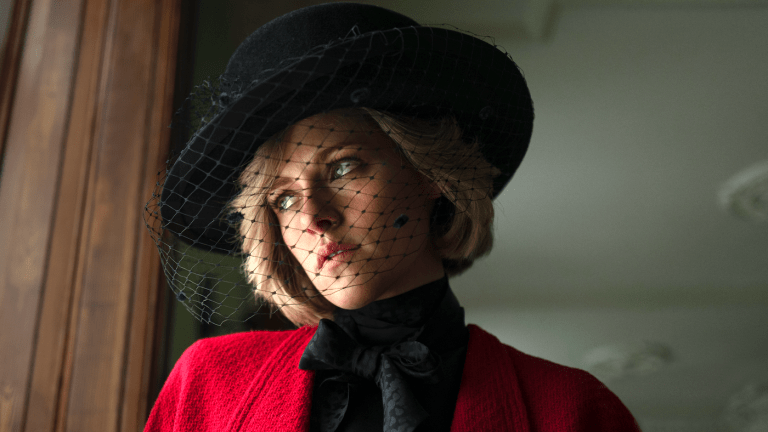Spencer: Kristen Stewart Conjures Diana and Her Own Hollywood Ghosts
Kristen Stewart nails the role of Lady Diana Spencer with a knowingness that's harrowing, and seemingly informed by her own horror stories.

Little girls growing up wanting to be princesses might think again after seeing Kristen Stewart in this dramatized snapshot of three days in the life of the late ‘people’s princess,’ Lady Diana Spencer. Though the movie doesn’t deal with Diana’s death, the looming knowledge of what is to come for the young mother hangs heavy throughout. But instead of directly dealing with that sorrow, Pablo Larraín’s “fable from a true tragedy” focuses on the gilded cage of Diana’s life over Christmas Eve, Christmas Day, and Boxing Day in 1991. What results is one the most depressing Christmas movies of recent times.
Spencer opens with a close up shot of a dead pheasant, as a multitude of land rovers bring lavish supplies to Sandringham ahead of the seasonal celebrations, the wheels perilously close to the pheasant as they pass. Not a candle in the wind, then, this Diana, but a bird with its wings already clipped just waiting to have its head crushed by the unstoppable force of oncoming traffic. It’s a mood established from the first which is pervasive throughout.
Kristen Stewart plays Diana in what is perhaps Stewart’s finest performance to date. Fragile but furious, she’s a woman constantly on the verge of tears while a desire for a full-on rebellion bubbles underneath. Despite not being British (though she nails the accent), Stewart might just be the perfect actor for the part. Thrust into stardom via her role in the Twilight movies, Stewart’s love life—and in particular her relationship with her co-star Robert Pattinson—was scrutinized by the press and fans in ways that can only have made her sympathetic to the utter lack of privacy in the face of her failing marriage Diana experienced.
While you can never know what’s going on in a performer’s mind, shots of the paparazzi hounding Diana on Christmas morning, with the perceived blame of this antagonistic relationship falling squarely on Lady Spencer’s shoulders in her family’s eyes, can’t help but be reminiscent of the column inches spent criticizing Stewart for not smiling enough, and the utter ownership hardcore fans felt they had over her at the height of her Twilight fame. The scene where Diana’s curtains are sewn shut to “protect her” from the prying eyes of the press are akin to torture.
Cinematographer Claire Mathon’s camera fixates on Stewart’s face in moments like these, while members of the royal family are mere background blurs unless the princess is pushed to focus their way. This is a portrait of a lady trapped and it almost feels like Larraín is trying to force us to look inside her; it’s an extremely uncomfortable place to be.
Jonny Greenwood’s oppressive score is a big part of that discomfort. From syncopated jazz indicating Diana’s muddled state of mind to a loud string quartet during a fantasy sequence where Diana imagines eating the pearls from the necklace Charles has given her, music is used as an effective assault—another device to show how trapped and locked into her own head she is.
Spencer is also repetitive, deliberately so. The film follows three days of carefully orchestrated activity. On the surface, it’s dresses, photographs, ceremony, ritual, a family united, but behind the scenes Diana’s life isn’t her own. She is constantly being watched, has no friends to speak of other than certain members of staff, and deals with this by binging and purging, self-harm, mania, and depression. The only moments of reprieve are snatched times with her children who clearly love their mother but are torn by the responsibility of the life they are born into.
Larraín’s movie—as stated at the start—is a fable, and not a straight biopic, and therefore certain moments have a sense of fantasy about them: Diana sneaking out and dressing a scarecrow in one of her royal outfits at her childhood home, for example, or a fairytale ending which comes with the weight of knowledge of what will befall Diana.
Nor is the film too concerned with some of the specific surrounding details of Diana’s life. Camilla Parker Bowles is a peripheral presence, and Diana is devastated when she learns Charles has given her the same gift of pearls as he has Diana. But her interactions with the family are minimal. They treat her as a liability, a volatile livewire who needs to be managed for the sake of the reputation of the status quo.
It’s with the staff that Diana feels most herself. Sean Harris as kitchen head Darren is a sympathetic ally who can’t change things for Diana but can at least offer her honesty. Diana’s dresser Maggie appears to be the closest she has to a real friend while Timothy Spall’s Major Alistar Gregory, charged with keeping tabs on the Princess, is a constant captor and a menace in the background.
Closer in tone to Black Swan than The Queen, Spencer veers into Gothic horror territory. It’s melodramatic, it’s larger than life. And half of it is almost certainly not what specifically happened. But as a depiction of the utter horror of being one of the most famous women in the world because of your relationship with a family who appears to neither like nor trust you, it’s terrifying. One speculates Stewart understands exactly how too.
Spencer opens in cinemas on Nov. 5.
